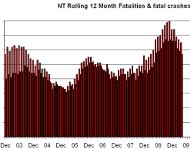Article from: www.thenewspaper.com/news/28/2840.asp
7/17/2009
Australia: Deaths Go Up After Speed Limits Imposed
Imposing a speed limit on the Australian equivalent of the Autobahn created an increase in fatalities.
 Up until 2007, rural roads in the Northern Territory, Australia had no speed limit. Claiming that speed limits were essential to saving lives, the state government imposed a 130km/h (80 MPH) limit on the Stuart, Arnhem, Victoria and Barkly highways and a 110km/h (68 MPH) speed limit on all other roads, unless otherwise marked lower. Despite the best of intentions, however, the number of road deaths actually increased 70 percent after the change -- despite worldwide drop in traffic levels (view chart).
Up until 2007, rural roads in the Northern Territory, Australia had no speed limit. Claiming that speed limits were essential to saving lives, the state government imposed a 130km/h (80 MPH) limit on the Stuart, Arnhem, Victoria and Barkly highways and a 110km/h (68 MPH) speed limit on all other roads, unless otherwise marked lower. Despite the best of intentions, however, the number of road deaths actually increased 70 percent after the change -- despite worldwide drop in traffic levels (view chart).
"Our roads are safer, vehicles are safer, paramedics more skilled, drought affected roads are dry, the public have never been more aware of speed limit enforcement, penalties have never been tougher," RoadSense founder Harry Brelsford explained. "These factors should have driven the road toll lower than before. They have not, it is rising. Clearly more of the same is not only not working, it is killing people."
The Australian motorist rights group compiled the latest road fatality data provided by the Northern Territory Police. In 2006, the last year without rural highway speed limits, the road toll was 44. Last year, with speed limits on all roads, the death toll grew to 75 (view data, 400k PDF). The proliferation of speed cameras throughout the country has also increased the level of hazard faced by motorists.
In all of Australia, the death toll decreased by nearly a third between 1989 and 1996 -- without automated enforcement. In the next eight years following the introduction of speed cameras, 1997-2004, fatalities only dropped ten percent. Between 2005 and 2007, the death rate began to skyrocket.
"A major reason for the failure of the policy is the extreme focus on the dangers of above the limit travel to the exclusion of nearly all other risk factors," Brelsford said. "This implies that traveling below the speed limit is safe, leading to complacency, inattention and increased fatalities. Additionally, the current policy of hidden speed cameras has actually impaired driver awareness through adding to an increasing list of dangerous distractions."
RoadSense advocates setting speed limits at the 85th percentile speed, or the speed at which the vast majority are comfortable traveling. The group suggests that government efforts would be better directed at the 98 percent of accidents that happen while traveling at or below the posted speed limit.
 Up until 2007, rural roads in the Northern Territory, Australia had no speed limit. Claiming that speed limits were essential to saving lives, the state government imposed a 130km/h (80 MPH) limit on the Stuart, Arnhem, Victoria and Barkly highways and a 110km/h (68 MPH) speed limit on all other roads, unless otherwise marked lower. Despite the best of intentions, however, the number of road deaths actually increased 70 percent after the change -- despite worldwide drop in traffic levels (view chart).
Up until 2007, rural roads in the Northern Territory, Australia had no speed limit. Claiming that speed limits were essential to saving lives, the state government imposed a 130km/h (80 MPH) limit on the Stuart, Arnhem, Victoria and Barkly highways and a 110km/h (68 MPH) speed limit on all other roads, unless otherwise marked lower. Despite the best of intentions, however, the number of road deaths actually increased 70 percent after the change -- despite worldwide drop in traffic levels (view chart).